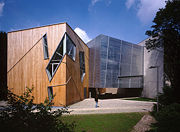
Felix Nussbaum Haus
Encyclopedia

Osnabrück
Osnabrück is a city in Lower Saxony, Germany, some 80 km NNE of Dortmund, 45 km NE of Münster, and some 100 km due west of Hanover. It lies in a valley penned between the Wiehen Hills and the northern tip of the Teutoburg Forest...
, Germany
Germany
Germany , officially the Federal Republic of Germany , is a federal parliamentary republic in Europe. The country consists of 16 states while the capital and largest city is Berlin. Germany covers an area of 357,021 km2 and has a largely temperate seasonal climate...
, which houses the paintings of German-Jewish painter
Painting
Painting is the practice of applying paint, pigment, color or other medium to a surface . The application of the medium is commonly applied to the base with a brush but other objects can be used. In art, the term painting describes both the act and the result of the action. However, painting is...
Felix Nussbaum
Felix Nussbaum
Felix Nussbaum was a German-Jewish surrealist painter. Nussbaum’s artwork gives a rare glimpse into the essence of one individual among the victims of the Holocaust.- Early life and education :...
. The building also houses an exhibition space, which focuses on racism and intolerance.
Origins
In 1991, the city of Osnabrück, Germany, decided to dedicate a museum to one of its natives, Felix Nussbaum, a Jewish painter who died in the Holocaust. In 1996, Daniel LibeskindDaniel Libeskind
Daniel Libeskind, is an American architect, artist, and set designer of Polish-Jewish descent. Libeskind founded Studio Daniel Libeskind in 1989 with his wife, Nina, and is its principal design architect...
's proposal, titled "Museum Without Exit," won the competition
Architectural design competition
An architectural design competition is a special type of competition in which an organization or government body that plans to build a new building asks for architects to submit a proposed design for a building. The winning design is usually chosen by an independent panel of design professionals...
to design the building, which was completed in 1998.
Design
The museum consists of three intersecting "volumes." The oakOak
An oak is a tree or shrub in the genus Quercus , of which about 600 species exist. "Oak" may also appear in the names of species in related genera, notably Lithocarpus...
volume houses Nussbaum's prewar art. The second volume, which slices violently through the first, is made from concrete and contains the paintings Nussbaum made while in hiding from the Nazis. Dubbed "Nussbaum Gang," it evokes the cramped quarters in Brussels
Brussels
Brussels , officially the Brussels Region or Brussels-Capital Region , is the capital of Belgium and the de facto capital of the European Union...
where Nussbaum painted his last canvasses. The metal volume displays the artist's newly-discovered paintings. The interior is labyrinthine and many paths lead to dead ends. The museum's sides face three cities where Nussbaum studied art: Berlin
Berlin
Berlin is the capital city of Germany and is one of the 16 states of Germany. With a population of 3.45 million people, Berlin is Germany's largest city. It is the second most populous city proper and the seventh most populous urban area in the European Union...
, Rome
Rome
Rome is the capital of Italy and the country's largest and most populated city and comune, with over 2.7 million residents in . The city is located in the central-western portion of the Italian Peninsula, on the Tiber River within the Lazio region of Italy.Rome's history spans two and a half...
, and Hamburg
Hamburg
-History:The first historic name for the city was, according to Claudius Ptolemy's reports, Treva.But the city takes its modern name, Hamburg, from the first permanent building on the site, a castle whose construction was ordered by the Emperor Charlemagne in AD 808...
. The fourth side faces the concentration camp where he was killed. The galleries house approximately 160 of Nussbaum's paintings.
Reaction
According to The TimesThe Times
The Times is a British daily national newspaper, first published in London in 1785 under the title The Daily Universal Register . The Times and its sister paper The Sunday Times are published by Times Newspapers Limited, a subsidiary since 1981 of News International...
, the museum, whose "narrow tunnel and subdued lighting impose an atmosphere of oppression,""clearly uses the idiom of displacement, loss and incomprehension." Jonathan Glancey
Jonathan Glancey
Jonathan Glancey is an architectural critic and writer who is the architecture and design editor at The Guardian, a position he has held since 1997. He previously held the same post at The Independent. He also has been involved with the architecture magazines Building Design, Architectural Review,...
, in The Guardian
The Guardian
The Guardian, formerly known as The Manchester Guardian , is a British national daily newspaper in the Berliner format...
, calls it "a masterpiece...in architectural dialogue with the paintings hung on its walls." Detractors, however, have said that Nussbaum's work is powerful enough on its own that it would have benefitted from being exhibited in a more neutral space.

